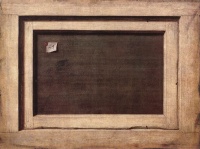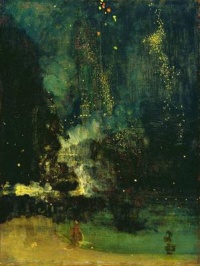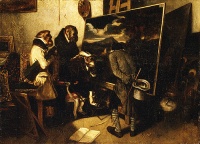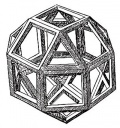Painting
From The Art and Popular Culture Encyclopedia
_by_Arcimboldo_in_the_Kunsthistorisches_Museum_Wien.jpg)
|
"Painting has not always existed; we can determine when it began. And if its development and its moments of greatness can be drummed into our heads, can we not then also imagine its periods of decline and even its end, like any other idea?"-- Challenge to Painting (1930) by Louis Aragon, epigraph in "The End of Painting" (1981) by Douglas Crimp "The Hockney–Falco thesis by artist David Hockney and physicist Charles M. Falco suggests that advances in realism and accuracy in the history of Western painting since the Renaissance were primarily the result of optical aids such as the camera obscura, camera lucida, and curved mirrors."--Sholem Stein "Geschichte der Malerei [...] treats the entire development of European painting from the downfall of the antique world to the early nineteenth century [...] [and interprets] the great styles of painting from the psychology of the age in which they originated."--The History of Painting: From the Fourth to the Early Nineteenth Century (1893/94) by Richard Muther |
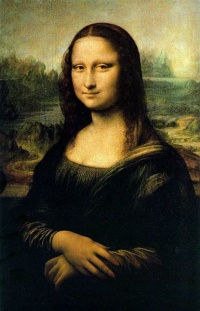
_by_Vilhelm_Hammershøi.jpg)

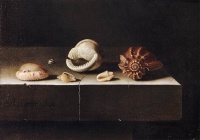
|
Related e |
|
Featured: |
Painting, meant literally, is the practice of applying color to a surface. However, when used in the context of the visual arts, the term "painting" means the use of this activity in combination with drawing, composition and other aesthetic considerations in order to manifest the expressive and conceptual intention of the practitioner.
Painting is used as a mode of representing, documenting and expressing all the varied intents and subjects that are as numerous as there are practitioners of the craft. Paintings can be naturalistic and representational (as in a still life or landscape painting), photographic, abstract, be loaded with narrative content, symbolism, emotion or be political in nature. A large portion of the history of painting is dominated by spiritual motifs and ideas; sites of this kind of painting range from artwork depicting mythological figures on pottery to biblical scenes to depictions of the human body itself as a spiritual subject.
Contents |
History
From prehistoric times to antiquity
The oldest known paintings are at the Grotte Chauvet in France, claimed by some historians to be about 32,000 years old. They are engraved and painted using red ochre and black pigment and show horses, rhinoceros, lions, buffalo, mammoth or humans often hunting. However the earliest evidence of painting has been discovered in two rock-shelters in Arnhem Land, in northern Australia. In the lowest layer of material at these sites there are used pieces of ochre estimated to be 60,000 years old. Archaeologists have also found a fragment of rock painting preserved in a limestone rock-shelter in the Kimberley region of North-Western Australia, that is dated 40 000 years old. There are examples of cave paintings all over the world—in India, France, Spain, Portugal, China, Australia, etc.
Oil painting
In Western cultures oil painting and watercolor painting have rich and complex traditions in style and subject matter.
The invention of photography
The invention of photography had a major impact on painting. In 1829, the first photograph was produced. From the mid to late 19th century, photographic processes improved and, as it became more widespread, painting lost much of its historic purpose to provide an accurate record of the observable world. There began a series of art movements into the 20th century where the Renaissance view of the world was steadily eroded, through Impressionism, Post-Impressionism, Fauvism, Expressionism, Cubism and Dadaism.
Modern and contemporary art
Modern and contemporary art has moved away from the historic value of craft and documentation in favour of concept; this led some to say in the 1960s that painting, as a serious art form, is dead. This has not deterred the majority of living painters from continuing to practice painting either as whole or part of their work. The vitality and versatility of painting in the 21st century belies the premature declarations of its demise. In an epoch characterized by the idea of pluralism, there is no consensus as to a representative style of the age. Important works of art continue to be made in a wide variety of styles and aesthetic temperaments, the marketplace being left to judge merit.
21st century art
Among the continuing and current directions in painting at the beginning of the 21st century are monochrome painting, hard-edge painting, geometric abstraction, appropriation, hyperrealism, Photorealism, Expressionism, minimalism, lyrical abstraction, pop art, op art, abstract expressionism, neo-expressionism, collage, intermedia painting, assemblage painting, computer art painting, postmodern painting, neo-dada painting, shaped canvas painting, environmental mural painting, traditional figure painting, landscape painting, portrait painting, and paint-on-glass animation.
See also
- The Painter of Modern Life
- Art
- Image
- Landscape painting
- Oil painting
- Painting within a painting
- Perspective
- Portrait painting
- Watercolor painting
- Western painting
- List of most expensive paintings
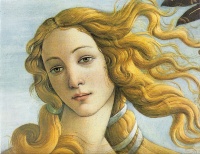
_by_Giovanni_Paolo_Panini.jpg)
